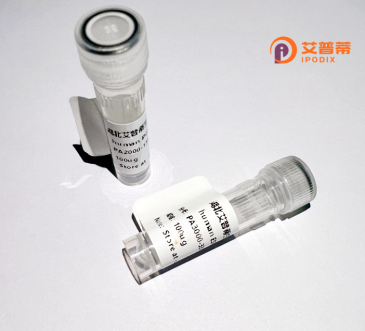
| 纯度 | >90%SDS-PAGE. |
| 种属 | Human |
| 靶点 | USP33 |
| Uniprot No | Q8TEY7 |
| 内毒素 | < 0.01EU/μg |
| 表达宿主 | E.coli |
| 表达区间 | 1-911 aa |
| 活性数据 | MSAFRNHCPHLDSVGEITKEDLIQKSLGTCQDCKVQGPNLWACLENRCSYVGCGESQVDHSTIHSQETKHYLTVNLTTLRVWCYACSKEVFLDRKLGTQPSLPHVRQPHQIQENSVQDFKIPSNTTLKTPLVAVFDDLDIEADEEDELRARGLTGLKNIGNTCYMNAALQALSNCPPLTQFFLDCGGLARTDKKPAICKSYLKLMTELWHKSRPGSVVPTTLFQGIKTVNPTFRGYSQQDAQEFLRCLMDLLHEELKEQVMEVEEDPQTITTEETMEEDKSQSDVDFQSCESCSNSDRAENENGSRCFSEDNNETTMLIQDDENNSEMSKDWQKEKMCNKINKVNSEGEFDKDRDSISETVDLNNQETVKVQIHSRASEYITDVHSNDLSTPQILPSNEGVNPRLSASPPKSGNLWPGLAPPHKKAQSASPKRKKQHKKYRSVISDIFDGTIISSVQCLTCDRVSVTLETFQDLSLPIPGKEDLAKLHSSSHPTSIVKAGSCGEAYAPQGWIAFFMEYVKRFVVSCVPSWFWGPVVTLQDCLAAFFARDELKGDNMYSCEKCKKLRNGVKFCKVQNFPEILCIHLKRFRHELMFSTKISTHVSFPLEGLDLQPFLAKDSPAQIVTYDLLSVICHHGTASSGHYIAYCRNNLNNLWYEFDDQSVTEVSESTVQNAEAYVLFYRKSSEEAQKERRRISNLLNIMEPSLLQFYISRQWLNKFKTFAEPGPISNNDFLCIHGGVPPRKAGYIEDLVLMLPQNIWDNLYSRYGGGPAVNHLYICHTCQIEAEKIEKRRKTELEIFIRLNRAFQKEDSPATFYCISMQWFREWESFVKGKDGDPPGPIDNTKIAVTKCGNVMLRQGADSGQISEETWNFLQSIYGGGPEVILRPPVVHVDPDILQAEEKIEVETRSL |
| 分子量 | 129.7 kDa |
| 蛋白标签 | GST-tag at N-terminal |
| 缓冲液 | PBS, pH7.4, containing 0.01% SKL, 1mM DTT, 5% Trehalose and Proclin300. |
| 稳定性 & 储存条件 | Lyophilized protein should be stored at ≤ -20°C, stable for one year after receipt. Reconstituted protein solution can be stored at 2-8°C for 2-7 days. Aliquots of reconstituted samples are stable at ≤ -20°C for 3 months. |
| 复溶 | Always centrifuge tubes before opening.Do not mix by vortex or pipetting. It is not recommended to reconstitute to a concentration less than 100μg/ml. Dissolve the lyophilized protein in distilled water. Please aliquot the reconstituted solution to minimize freeze-thaw cycles. |
以下是关于重组人USP33蛋白的3篇参考文献及其摘要内容的简要概括:
1. **文献名称**: "USP33 deubiquitinates the RhoGEF ECT2 to promote APC/C activation and anaphase progression"
**作者**: Luo et al. (2021)
**摘要**: 该研究通过表达重组人USP33蛋白,证明其通过去泛素化RhoGEF蛋白ECT2调控有丝分裂中APC/C复合物的激活,促进细胞周期后期进程。
2. **文献名称**: "Structural insights into the activation mechanism of USP33 by CK2-mediated phosphorylation"
**作者**: Wang et al. (2019)
**摘要**: 利用重组USP33蛋白解析了其晶体结构,发现CK2激酶介导的磷酸化通过构象变化激活USP33的去泛素化酶活性,揭示了其在信号传导中的调控机制。
3. **文献名称**: "USP33 regulates EGFR endocytic sorting through deubiquitinating activity"
**作者**: Yin et al. (2017)
**摘要**: 研究采用重组人USP33蛋白进行体外泛素化实验,表明其通过去除EGFR的泛素链调控受体内吞分选,影响下游MAPK信号通路的活性。
这些文献涵盖了USP33的结构、功能及其在细胞周期和信号通路中的作用,均涉及重组蛋白的表达与应用。
Recombinant human USP33 (Ubiquitin-Specific Protease 33) is a deubiquitinating enzyme (DUB) encoded by the USP33 gene. Belonging to the ubiquitin-specific protease family, it selectively cleaves ubiquitin moieties from substrate proteins, thereby regulating protein stability, localization, and activity. USP33 plays a pivotal role in diverse cellular processes, including receptor trafficking, DNA damage response, and signal transduction pathways such as β-arrestin-mediated GPCR signaling and hypoxia-inducible factor (HIF) regulation. Its involvement in modulating ciliogenesis and the circadian clock further underscores its functional versatility.
Produced through recombinant DNA technology, the USP33 protein is typically expressed in bacterial (e.g., E. coli) or mammalian systems, ensuring proper post-translational modifications and catalytic activity. The recombinant form retains conserved domains, including the USP catalytic core with characteristic cysteine and histidine residues critical for enzymatic function. Researchers utilize purified USP33 to study substrate specificity, enzyme kinetics, and protein-protein interactions, often employing techniques like deubiquitination assays and mass spectrometry.
Dysregulation of USP33 has been linked to cancer progression, neurodevelopmental disorders, and respiratory diseases, making it a potential therapeutic target. Current research explores its dual regulatory roles – promoting or degrading substrates depending on cellular context – and its impact on drug resistance mechanisms. Ongoing structural studies aim to elucidate its substrate recognition patterns for targeted inhibitor design.
×